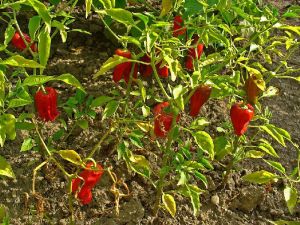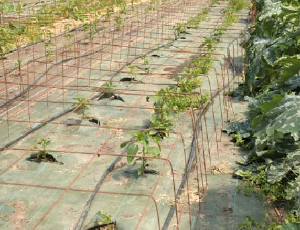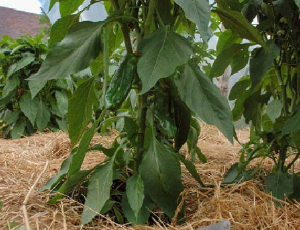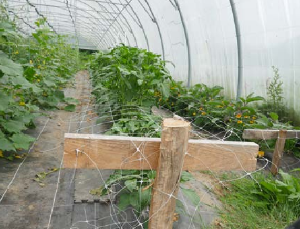Bell pepper

The cultivation schedule for sweet peppers is very similar to that of aubergines. It needs a lot of heat heat requirements. Its advantage is that it can be sold green (immature). Production can sometimes last if the autumn is mild.
Preparing the soil
Peppers are a demanding crop, so it is advisable to add plant compost, animal manure, etc. is recommended. The pepper is grown on a tarpaulin or on organic mulch, with straw straw is added to greenhouses to a thickness of 10 to 30 cm. If planted on mulch, apply the straw after the last frosts after the last frosts when you remove the protective protective covers.



Planting on a tarpaulin (silage or woven) is recommended, especially in regions with less sun or for the first series. sun or for the first series. In this case, the drip under the tarpaulin. To do this, irrigate and cover with a silage tarpaulin. silage tarpaulin.
Finally, peppers like deep, well-drained soil that is rich in humus. rich in humus, so living soils are ideal. For heavy, clay soils, cultivation on mounds is preferable.
Planting
Seedlings are sown in a nursery 8 weeks before planting, then repotted. then repotted, whether the seed is sown in a terrine or on trays. To obtain vigorous, stocky plants vigorous, stocky plants, it is advisable to maximise photosynthesis by spacing the plants apart and protecting them from the cold. from the cold. Pepper plants are demanding, with a fairly high germination temperature and wide temperature differences between day and night. between day and night are not appreciated. appreciated.
Ideally, plant at the 15 to 20 cm stage, with a few flower buds flower buds forming, without burying the crown. For earlier production, peppers can be planted earlier be planted earlier, using forcing sails at night to protect them from at night to protect it from the cold. Planting early is a risk risk that can be taken for part of the production.
Tip : Peppers grow poorly if they are not staked, and there is a high risk of breakage under the weight of the fruit.
Monitoring cultivation
When plants exceed 40 cm in height, to avoid breakageor lodging or lodging, use a trellising system with one of the following following systems :
- Tying a string to the support or a cotton thread mounted on a spool. The stalk is either rolled up (risk of breakage) or clipped to the wire for easy attachment.
- Vertical trellising in a hedge with 2 nets, held in place by string and stakes, and surrounding the crop.
- Horizontal trellising : multi-tiered cages made of concrete trellis or sheep netting, placed around the plant in the first few weeks.
Pruning, which is not carried out systematically, consists of removing removing the first fruits or flowers at the first node toencourage root development at the start of the crop. A the 3rd node, cut off every second branch (preferably those branches (preferably those going towards the inside of the plant) to improve bush cover and encourage fruit ripening in relation to vegetative development.
Thinning out the leaves at the base of the plant is not systematic, but helps to to aerate the plant.
Irrigation
Use regular, deep drip irrigation, adapted to the weather adapted to the weather and in the morning to avoid problems problems of blossom end rot. Excessive watering is harmful and requirements increase from fruit set onwards. When the weather is hot, a quick sprinkling will reduce the temperature in the greenhouse (this should be kept under control as it can this can encourage fungal diseases).
Harvest
Harvest the firm fruit twice a week using spruce. Leave to ripen for 3 weeks to 1 month after the green stage. to harvest colourful peppers. A harvesting trolley to make harvesting easier and more ergonomic. Clean cutting tools regularly to prevent disease.
Storage
Peppers can be stored for only a short time, in acool cool (12°C).
Pests and diseases
Aphids on young plants.
- Bugs on flowers can cause fruit abortion.
- Blossom end rot : provide abundant irrigation, especially during hot periods when the fruit is ripening.
- Mites : drench with water.
Adapting to the soil and climate
Peppers grow earlier and produce longer in warm in warm regions with few frosts. Overwintering sails improve earliness slightly.
Photo gallery
Sources
- This page is based on the guide Introduction au maraîchage sol vivant from MSV Normandie.
